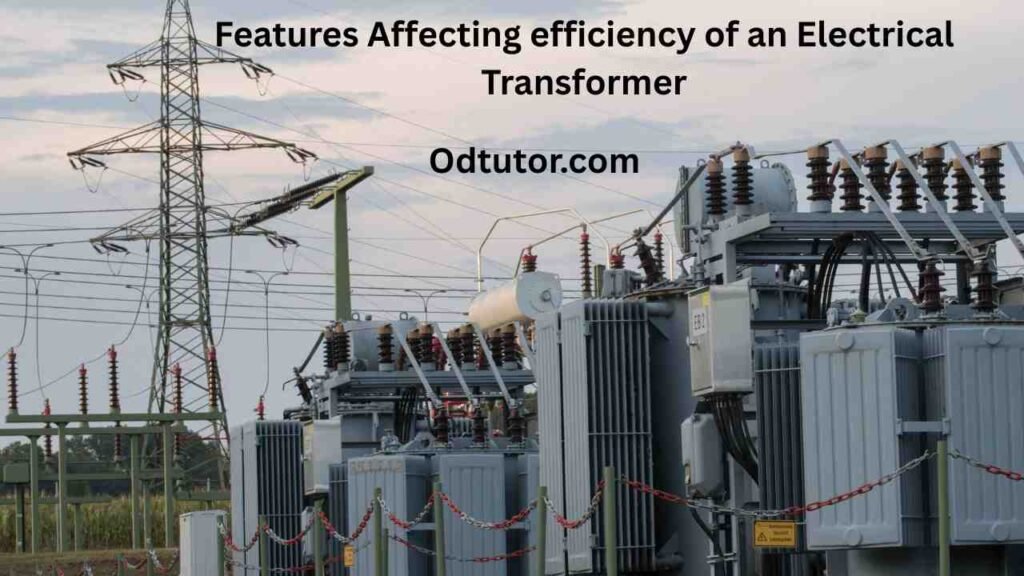When analyzing the efficiency of an electrical transformer, both numerical (quantitative) and categorical (qualitative) features can influence performance. Here’s a structured breakdown:
⚙️ Numerical Features (Quantitative Variables)
These directly affect losses, heat generation, and voltage regulation.
| Feature | Description | Effect on Efficiency |
|---|---|---|
| Input Voltage (V₁) | Primary side voltage in volts | Deviation from rated voltage increases core losses |
| Output Voltage (V₂) | Secondary side voltage in volts | Affects voltage regulation and load efficiency |
| Load Current (I₂) | Secondary current in amperes | Higher current increases copper losses |
| Frequency (f) | Supply frequency in Hz | Core losses depend on frequency; efficiency decreases if frequency deviates from design |
| Rated Power (kVA/MVA) | Transformer capacity | Larger transformers often have higher efficiency due to reduced relative losses |
| Core Loss (Iron Loss, W) | Constant loss from hysteresis and eddy currents | Higher core loss reduces efficiency at no-load |
| Copper Loss (W) | Load-dependent loss due to winding resistance | Major loss component under load; increases with square of load current |
| Temperature Rise (°C) | Rise above ambient | Excessive temperature increases resistance and reduces efficiency |
| Ambient Temperature (°C) | External temperature | High ambient reduces cooling efficiency |
| Winding Resistance (Ω) | Electrical resistance of windings | Higher resistance means higher copper losses |
| Magnetizing Current (A) | Current required to energize the core | Affects no-load losses |
| Power Factor (cos φ) | Load power factor | Poor power factor reduces apparent efficiency under load |
| Oil Level / Flow Rate | In oil-cooled transformers | Affects cooling and indirectly efficiency |
| Flux Density (Tesla) | Magnetic field strength in the core | High flux density increases core losses |
🔧 Categorical Features (Qualitative Variables)
These describe material, design, and operational characteristics.
| Feature | Categories / Examples | Effect on Efficiency |
|---|---|---|
| Transformer Type | Distribution, Power, Auto, Instrument, etc. | Efficiency varies by design and application |
| Cooling Method | ONAN, ONAF, OFAF, OFWF, Dry type | Affects heat dissipation and continuous load capability |
| Core Material | CRGO steel, Amorphous steel, Ferrite | Better materials reduce hysteresis and eddy current losses |
| Winding Material | Copper, Aluminum | Copper offers lower resistance → higher efficiency |
| Insulation Class | Class A, B, F, H | Determines allowable temperature rise and reliability |
| Mounting Type | Pole-mounted, Pad-mounted, Indoor | Affects ventilation and cooling efficiency |
| Load Type | Industrial, Residential, Non-linear, Balanced | Load characteristics influence harmonic losses |
| Connection Type | Δ–Y, Y–Δ, Y–Y, Δ–Δ | Influences harmonics, neutral current, and phase balance |
| Regulation Type | Fixed tap, On-load tap changer (OLTC) | Affects ability to maintain efficiency under varying loads |
| Cooling Medium | Air, Mineral oil, Ester oil | Impacts cooling and thermal performance |
| Operating Environment | Urban, Rural, Coastal, Industrial | Dust, humidity, and salinity can degrade insulation efficiency |
| Manufacturer / Design Standard | IEC, IS, ANSI designs | Standards ensure different levels of efficiency compliance |
🧮 Efficiency Relationship Example

Where:
- ( P_{core} ) = Iron (core) loss (constant)
- ( P_{cu} ) = Copper loss (variable, ∝ I²)
1. Where Aluminum Windings Are Used
| Transformer Type | Typical Winding Material | Reason / Justification |
|---|---|---|
| Distribution Transformers (≤ 500 kVA) | ✅ Aluminum or Copper | Aluminum is cheaper and lighter — used widely by utilities for pole-mounted and pad-mounted distribution transformers. |
| Power Transformers (> 1 MVA) | ✅ Copper (mostly) | Copper offers higher conductivity and better mechanical strength, essential for high-current, high-voltage operations. |
| Dry-Type Transformers | ✅ Both (depending on cost and space) | Aluminum used where cost and weight are more critical than compactness. |
| Instrument / Control Transformers | ✅ Copper | Accuracy and stability are more important — copper preferred. |
2. Aluminum vs Copper – Comparison for Transformer winding
| Property | Copper | Aluminum |
|---|---|---|
| Conductivity | 100% (reference) | ~61% of copper |
| Density | 8.96 g/cm³ | 2.70 g/cm³ (≈ 3x lighter) |
| Cost | Higher | ~50–60% cheaper |
| Cross-sectional Area | Smaller (for same current) | Needs ~1.6x larger cross-section |
| Oxidation | Minimal | Forms oxide layer (must be handled carefully) |
| Mechanical Strength | Stronger | Softer; more prone to creep under stress |
| Thermal Expansion | Lower | Higher — needs design compensation |
| Efficiency Impact | Higher efficiency, smaller losses | Slightly lower efficiency due to higher resistance |
3. Industry Practice
- Utilities (like in India, USA, Europe) often use aluminum-wound distribution transformers because they’re:
- Cheaper upfront
- Lighter (easier to mount on poles)
- Sufficient for typical load profiles (80–90% rated load)
- Industrial users or private installations prefer copper-wound transformers for:
- Better overload capacity
- Lower operating losses (high
In summary:
✅ Yes — aluminum windings are common in smaller and cost-sensitive distribution transformers.
❌ Copper is dominant in high-capacity or precision transformers where performance and reliability matter more than cost.

